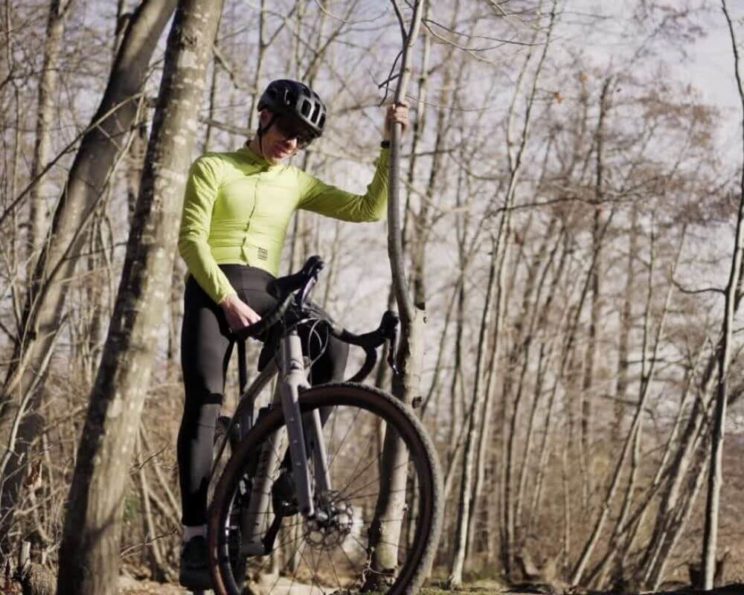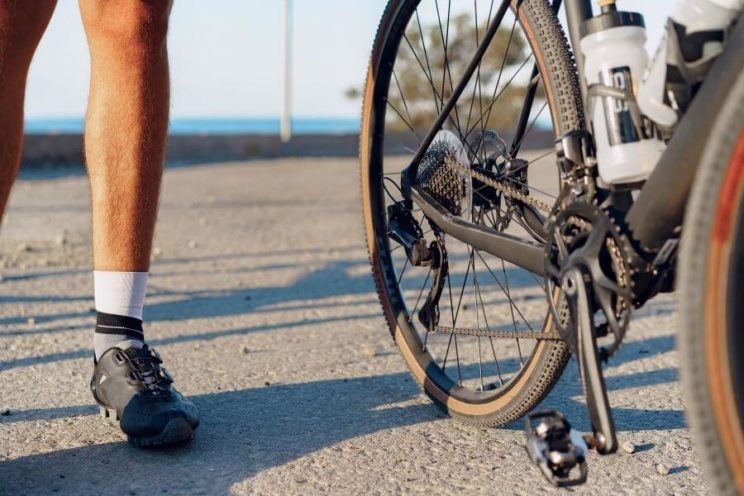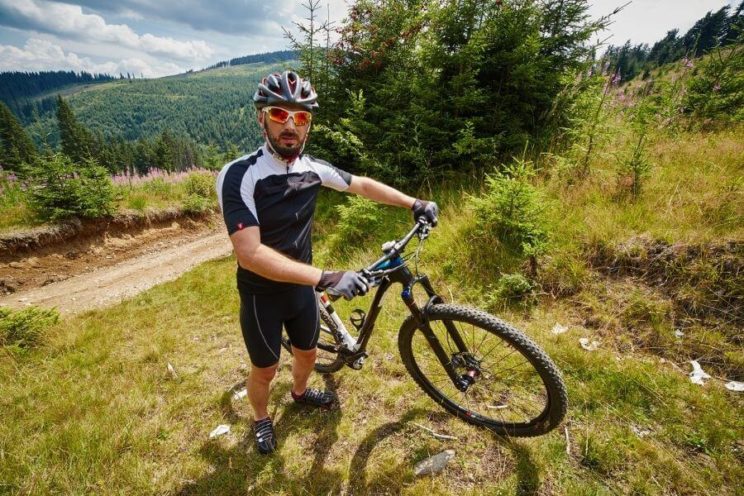What are the differences between a serious bicycle and a mountain bike or MTB? It can be a difficult matter to understand for novel cyclists, since both share many characteristics.
GraveL bicycles are designed to offer good performance on rugged land, but not extreme, both out and inside the asphalt. The same serve for dirt roads than for clues or stretches of asphalt. It is not always easy to define what is serious and what is not, but we know something with certainty: serious bicycles are not mountain bicycles.
[IRP posts = "3350" name = "What is a serious bicycle for?"]
MTB bikes are made for a much more off -road pilot. Suspension endowed (yes, we already know that some serious bikes begin to use it), straight handlebars and a particular geometry, mountain bicycles are able to face a greater variety of land compared to serious bicycles.
Although grave bikes can develop
OFF-ROAD With good performance, they are not suitable for rocky descents, trialeras or steep paths sown with roots. Its narrower tires and lack of suspension are factors that play against.
[Captation Id = "Attachment_9122" Align = "Alignnone" Width = "744"]

(Image: Getty)[/caption]
Gravell bicycles have other strengths.
They are fast. With little drawing tires inflated to about 3 kg, most serious bicycles can roll almost as fast as a road bike. His paintings are light and agile, and the sensation on the asphalt is very similar. The handlebars with fall and a geometry with a certain touch
Racing They help in this regard.
It is a very fun sensation to navigate with a grave on a track at full speed and feel, at the same time, a grip that remembers that of mountain bicycles.
Regarding the competition, mountain cycling is much more consolidated than Gravel races, which are still taking their first steps. International MTB competitions have been for decades, and include male and female races in multiple modalities, such as Cross-Country (STXC), marathon, enduro and descent.
Gravel races, meanwhile, take their first steps and have more to do with ultra -resistance. The most popular competitions in the world usually last between 5 and 10 hours, with tours above 300 km and 3,000 m of unevenness. Many of the best serious cyclists in the world, at least for now, have been - or son -professionals of the WorldTour: Laurens Ten Dam, Thomas Dekker, Peter Stetina, Ted King ...
Competition outside, the popularity of Gravel took off as a rocket just a few years ago. Millions of cyclists from all over the world launched bicycles, but in many cases without really knowing what they were looking for.
Here we present some similarities and differences between serious bicycles and mountain bicycles.
Wheels and tires
One of the characteristics that define serious bicycles is the amplitude of the wheel pass, which in many cases allows mounting up to 50 mm. In this way, they allow rolling with a huge variety of tires. In fact, it is common for Elite Grave Cyclists to change each other depending on the land and the technical difficulty of the races.
In any case, mountain bike tires play
In another league If we compare them with maximum performance grave tires. The former are designed to cope with bachelor, roots, stones and rocks, etc. The MTB covers are significantly wider (from 2.2 "it is usually the usual) and often use more pronounced rolling bands for traction in the mud. In addition, they are much thick and can include flanks with anti -infinite protection.
Mountain bicycle tires play In another league If we compare them with maximum performance grave tires.
Although it may seem that a serious bike with wide tires and tacos is able to face paths
Ratoneros, it is really much less protected against punctures than a mountain bike tire.
Marches and brakes
Actually, there are enough similarities between serious bicycles and mountain bicycles in regard to changes and brakes. In fact, grave bikes have been adopting more and more technologies that were previously exclusive to MTB. The monoplat transmissions or disc brakes are two classic examples.
There are countless change options for both serious bicycles and mountain bicycles, and you can find settings that include one, two, or even three dishes. The Grave world is still quite divided into the 1x or 2x configurations. Normally, the choice depends on the place through which it circulates. If you live on a plain, you probably don't need a 2x configuration with a huge cassette. But if you like
Give you cane On increases of 20%, you will look for the highest possible gear range.

On mountain bicycles the 1x configuration is already a standard. Component manufacturers have been able to design a huge range of crowns in the cassette (10 to 50 teeth, for example), allowing the right march to always adopt; It doesn't matter if you go at 8 km/h or 35 km/h.
Long before road cycling resolved on the question of hydraulic disc brakes, these were already the preferred option in MTB. They offer much higher power, modulation and durability on roads and paths. Gravell bicycles collected the witness since its inception.
Table geometry
At first glance (and only with the naked eye), GraveL bicycles are designed very similar to road bicycles. The cyclist adopts on them a position that keeps a balance between aerodynamics and comfort: neither very erect, nor very
Aero.
In general, serious bicycles are shorter than mountain, which have faster steering angles and longer axes.
[IRP Posts = "9684" Name = "Grave Bike Geometry: Different from one road?"]
MTB models are designed for technical land. A
REACH Longer makes them more stable at speed, especially in abrupt lands. The most closed steering angle helps to keep the center of gravity of the cyclist in the pronounced descents balanced, while the short powers and wide handlebars improve the lever effect and maneuverability.
These straight handle of mountain bicycles also improve grip and stability in jumps or technical grounds, where a greater lever effect is beneficial.
Suspensions
In general, a conventional serious bike does not set suspensions, although some do carry them. However, even setting them, they have a much shorter route than that of a mountain bike. There may be serious models with 20-30 mm, which have little to do with enduro models 140 or 170 mm.
Unlike grave bikes, most market bikes are divided into two categories: rigid (or semi -rigid, to be more precise), with a suspension in the fork, and double suspension, with shock absorber also in the central part of the bike.
The former are cheaper, simpler maintenance and with lighter pictures, which allows good performance in the Cross-Country modality and in tests where speed and reactivity are sought.
Handlebars
One of the biggest differences between serious bicycles and mountain bicycles are their handlebars. Gravell bicycles normally ride curved handles similar to roads, while Mountain Bikes use straight handlebars, or with a slight curvature. This significantly affects the handling of each bicycle, as well as the position and comfort of the cyclist for long days on the armchair.
In its front, serious bicycles provide a sensation very similar to that of a road bike. The cyclist can choose between three main positions to place the hands: in the handles, at the top or in the fall of the handlebar. The trend is usually spending most of the time with the hands in the covers. From there it is easy to reach the brake and change.
With the hands in the upper part it is much more complicated to stop or change gear quickly. Place your hands in the lower part of the handlebar provides easy safety and access to brake handles, so it is a very common posture in the descents. They also offer a more aerodynamic and aggressive driving position.
Mountain bicycles, meanwhile, use straight handlebars instead of handle with fall. Depending on the model, they can count on a slight curvature between the fists and the center of the handlebar, unlike Gravell handlebars, which seem
ram horns.

In the case of MTB cyclists, the position of the hands on the handlebar is always the same: supported by the handles of each end of the handlebar tube. Some advanced cyclists have the habit of putting their hands very close to power, to narrow the shoulders and adopt an aerodynamic position. Perhaps during a flat and unique tamo of a tour can make sense.
Ergonomics and marching position
Gravell's handlebars provide the cyclist more options to adapt their position on the bicycle. Unlike the most aggressive position that a road cyclist adopts, serious bicycles have a more resistance oriented geometry that allows them to pedal efficiently without leaning too forward.
Yes there are moments in which a more aggressive position is required. In fact, pedaling to the lower part of the handlebar of a Grance allows the bicycle to better control, although it can harm comfort and excessively force the back, neck or muscles of the arms.
A usual position on a serious bike is to support your hands on brake cover. Access to brakes is immediate. However, supporting the hands on the stops can offer significant relief when the pilot feels tired or experiences some discomfort in the lower back.
On the other hand, with your hands in this position, the control over the bike is lower; Especially, on roads with potholes, sandy trails or loose gravel. Therefore, it is not advisable to adopt this posture outside the asphalt or well -foled roads.
The
Bikers They usually adopt a very different posture on their MTB bikes, especially conditioned by straight handlebars and the geometry of the painting. The handlebars are quite wider than those that are mounted on serious bikes. The most common measure for an XC mountain bike ranges between 72 and 74 cm, while severe handlebars usually range between 40 and 46 cm, being 44 cm the most common. Consequently, on a pedaling mountain bike with the elbows much more open.
The Bikers They usually adopt a very different posture on their MTB bikes, especially conditioned by straight handlebars and the geometry of the painting.
This type of handlebars has its advantages, but they also penalize when maneuvering: the longer, the slower is the direction. In addition, they are aerodynamically less effective. In fact, there is a typology of serious competition bicycles specifically focused on speed.
Mountain bicycles place the cyclist in a relaxed and erect position, which is the best to take curves and control the bicycle with more security. However, in stirred paths with vegetation, a wide handlebar can cause unexpected impacts. Straight handlebars are not intended for speed. On the other hand, Gravel bicycles place the cyclist in a somewhat more posture
Racing.
 (Image: Getty)[/caption]
Gravell bicycles have other strengths.
They are fast. With little drawing tires inflated to about 3 kg, most serious bicycles can roll almost as fast as a road bike. His paintings are light and agile, and the sensation on the asphalt is very similar. The handlebars with fall and a geometry with a certain touch Racing They help in this regard.
It is a very fun sensation to navigate with a grave on a track at full speed and feel, at the same time, a grip that remembers that of mountain bicycles.
Regarding the competition, mountain cycling is much more consolidated than Gravel races, which are still taking their first steps. International MTB competitions have been for decades, and include male and female races in multiple modalities, such as Cross-Country (STXC), marathon, enduro and descent.
Gravel races, meanwhile, take their first steps and have more to do with ultra -resistance. The most popular competitions in the world usually last between 5 and 10 hours, with tours above 300 km and 3,000 m of unevenness. Many of the best serious cyclists in the world, at least for now, have been - or son -professionals of the WorldTour: Laurens Ten Dam, Thomas Dekker, Peter Stetina, Ted King ...
Competition outside, the popularity of Gravel took off as a rocket just a few years ago. Millions of cyclists from all over the world launched bicycles, but in many cases without really knowing what they were looking for.
Here we present some similarities and differences between serious bicycles and mountain bicycles.
(Image: Getty)[/caption]
Gravell bicycles have other strengths.
They are fast. With little drawing tires inflated to about 3 kg, most serious bicycles can roll almost as fast as a road bike. His paintings are light and agile, and the sensation on the asphalt is very similar. The handlebars with fall and a geometry with a certain touch Racing They help in this regard.
It is a very fun sensation to navigate with a grave on a track at full speed and feel, at the same time, a grip that remembers that of mountain bicycles.
Regarding the competition, mountain cycling is much more consolidated than Gravel races, which are still taking their first steps. International MTB competitions have been for decades, and include male and female races in multiple modalities, such as Cross-Country (STXC), marathon, enduro and descent.
Gravel races, meanwhile, take their first steps and have more to do with ultra -resistance. The most popular competitions in the world usually last between 5 and 10 hours, with tours above 300 km and 3,000 m of unevenness. Many of the best serious cyclists in the world, at least for now, have been - or son -professionals of the WorldTour: Laurens Ten Dam, Thomas Dekker, Peter Stetina, Ted King ...
Competition outside, the popularity of Gravel took off as a rocket just a few years ago. Millions of cyclists from all over the world launched bicycles, but in many cases without really knowing what they were looking for.
Here we present some similarities and differences between serious bicycles and mountain bicycles.
 On mountain bicycles the 1x configuration is already a standard. Component manufacturers have been able to design a huge range of crowns in the cassette (10 to 50 teeth, for example), allowing the right march to always adopt; It doesn't matter if you go at 8 km/h or 35 km/h.
Long before road cycling resolved on the question of hydraulic disc brakes, these were already the preferred option in MTB. They offer much higher power, modulation and durability on roads and paths. Gravell bicycles collected the witness since its inception.
On mountain bicycles the 1x configuration is already a standard. Component manufacturers have been able to design a huge range of crowns in the cassette (10 to 50 teeth, for example), allowing the right march to always adopt; It doesn't matter if you go at 8 km/h or 35 km/h.
Long before road cycling resolved on the question of hydraulic disc brakes, these were already the preferred option in MTB. They offer much higher power, modulation and durability on roads and paths. Gravell bicycles collected the witness since its inception.
 In the case of MTB cyclists, the position of the hands on the handlebar is always the same: supported by the handles of each end of the handlebar tube. Some advanced cyclists have the habit of putting their hands very close to power, to narrow the shoulders and adopt an aerodynamic position. Perhaps during a flat and unique tamo of a tour can make sense.
In the case of MTB cyclists, the position of the hands on the handlebar is always the same: supported by the handles of each end of the handlebar tube. Some advanced cyclists have the habit of putting their hands very close to power, to narrow the shoulders and adopt an aerodynamic position. Perhaps during a flat and unique tamo of a tour can make sense.
















